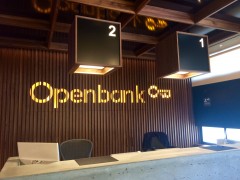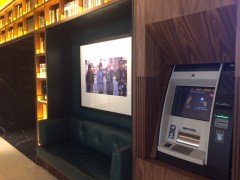Spain’s first fully digital bank Openbank in major transformation
Openbank, a subsidiary of Spain’s banking giant Santander, has undergone an enterprise-wide overhaul, from products and services, to technology, to corporate culture, to new branding.
Banking Technology was invited for an exclusive preview – and this report comes to you straight from sunny Madrid.
The bank has been in existence for 22 years. It focuses on the “professionals” segment by offering current accounts, savings, investment and lending solutions (including mortgages), debit and credit cards.
It has one million customers and over €6 billion in deposits.
It operates as a standalone subsidiary of Santander, with its own team, operations and P&L. As part of the renovation project, the staff – 130 people – has been brought together at one open-plan office at a Santander centre in Madrid. (Think table football, cool photos on the walls and modern design.)
A “horizontal organisational structure” was introduced as well as “flexibility for employees”.
Yet, Openbank sees itself as a start-up, says Ezequiel Szafir Holman, CEO of Openbank. Szafir, whose experience includes stints at Amazon, McKinsey and Cortefiel, joined Openbank just over a year ago.
“You must keep the mentality of a start-up to keep pushing, to keep going forward.”
Also, the start-up culture – “no set ways of doing things” – helps the bank to be open to trying new ways and encouraging innovation, he says.
Incumbents have an advantage of being well-entrenched, but what they miss is the knowledge of how to innovate and the sense of urgency, he observes.
“Stantander had this sense. And it wasn’t half-hearted – it was all go-go-go!”
All hands on deck
Around 15 months ago, Santander gave Openbank a so-called creative licence to reinvent itself. However, two principles were set: 1) Openbank had to be fully compliant; 2) it had to be a profitable business model.
“We started from scratch. Three months of intense research and 12 months to get-go to delivery,” Szafir says. “To achieve that, you have to be fully agile from day one. The same applied to our suppliers – they had to be agile or we wouldn’t work with them.”
Although “a journey of a digital company is never completed”, the bank has managed to achieve a lot in one year, he states.
“It’s not just a ‘cosmetic facelift’, i.e. a new website, but every process, front-to-back office, has been redefined and redesigned.”
What’s the tech?
A lot of emphasis was placed on machine learning solutions to gain a deeper understanding of a customer, provide faster risk analysis and to enhance marketing capability.
Szafir says it is working with fintech firms and start-ups through Santander InnoVentures (the fintech venture capital fund of Santander Group).
All front-end operations have been moved onto a public cloud.
At the back-end, the team “sliced” its legacy core banking system to move out as much functionality as possible and onto more modern and flexible solutions. Furthermore, core system replacement is on the agenda.
There is a full API layer “for every customer service”, says Szafir, so the bank is ready for the upcoming PSD2 and other regulations.
New mobile app
The mobile app has been fully redesigned. “There is an app proliferation in the industry – a separate app for your wallet, then another one for mobile banking and so on,” Szafir observes. So the bank’s challenge was to gather as much functionality as possible in one app. Openbank’s new app includes the wallet, broker/investment and personal finance management (PFM).
The aim was to make it clean, simple and easy to use, he states. “It’s all about the customer experience – a new simplified customer journey.”
At the same time, “we are not trying to reinvent the wheel”, he comments. The design and layout are kept clear and familiar to online users, keeping the look and feel to what people are familiar with when going online and using digital devices.
Inspired by Amazon’s “one click challenge”, the team introduced “one session challenge” – for a user to be able to successfully complete everything they have set out to in one session – which, Szafir admits, “is very difficult to do”.
Account opening can be done fully online and can take around six minutes if it is a straightforward case. Szafir notes that the development team has insured that when filling out an online form, an option to call/email an advisor or request a call-back is always visible on the screen.
If a customer already has a bank account in Spain (at any bank), the identification and verification can be done between banks “with a click of a button”, without customer involvement.
However, if a customer is new to banking in Spain (“we are not born with bank accounts”) – the verification is done online via a video call with an advisor. A photo of a passport/ID document is taken by an advisor during the call and is verified.
Szafir expects this process to be automated further. “With biometrics and authentication technology advancing so fast, I believe it will all change and be much more automated in two years time.”
All about personalisation
Szafir emphasises the driving factors for the app UX have been making it relevant, useful and simple for a customer.
A customer has an option to personalise his/her landing page once they log in – changing their greeting name and creating an avatar. The latter has been developed by a gaming software company.
The PFM tool enables them to categorise and track their expenditures, e.g. travel, food, apparel etc (machine learning software at the back-end automatically categorises the transactions). This, comments Szafir, has been the most popular feature.
In the brokerage space, the bank has introduced the “social investing” concept into the app. Users can see what their peer group is investing in, what shares are being bought and sold, what the trends are – keeping it relevant to a specific user.
“We are making investment very democratic,” Szafir says. “You can see the investments in real-time, you can buy and sell right away – and all that with just a few clicks.”
Users can also “personalise” debit and credit cards in the app – name them for easier identification (e.g. school fees, online shopping etc) and there is a one-click option to switch the cards off and on (the button looks strikingly similar to the on/off button for functionality on Apple devices).
When making large purchases, customers have an option of spreading their finance over a period of time, choosing the length and amount in the app, also “in a matter of a couple of clicks” and a comprehensive layout on the screen (as Banking Technology can confirm).
There is also a family-friendly feature in the app – a prepaid debit card for kids. Children can request a top-up from parents via the app with an option to explain the request. “This is the most fun bit,” Szafir notes.
Someone to talk to
A live person a customer can talk to is a vital component of a positive customer experience, Openbank believes.
Openbank operates an internal call centre and also uses an external one – both are located in Madrid.
Each customer is assigned to a certain “virtual branch” with five advisors – “each is a real person”, profiled in the app – so a customer can call, email or WhatsApp the advisor of their choice. The virtual branches are open extended hours during weekdays and shorter hours on the weekends.
For out-of-office hours, the call centre operates 24×7, including the WhatsApp communications.
“We aim to be a ‘first ring’ company,” Szafir states.
But wait, there is more – ten days ago Openbank opened physical doors to its first and only “brick and mortar” branch in Madrid.
The quirky design – which combines wood panelling, bookshelves filled with books of eclectic variety and clean modern lines – is a brainchild of a famous architect Lázaro Rosa-Violán (who also designed one of Madrid’s hot-spots for restaurant goers, Amazonico).
The branch has a footfall of around 200 people a day.
There is nothing you cannot do online that you can do in the branch, but it is an all-important human touch, Szafir notes. “Our branch is a statement, a flagship.”
“A digital bank shouldn’t be synonymous with things done ‘on the cheap’,” he states. Openbank’s target customers are professionals, he explains, so delivering quality throughout is a must.














































